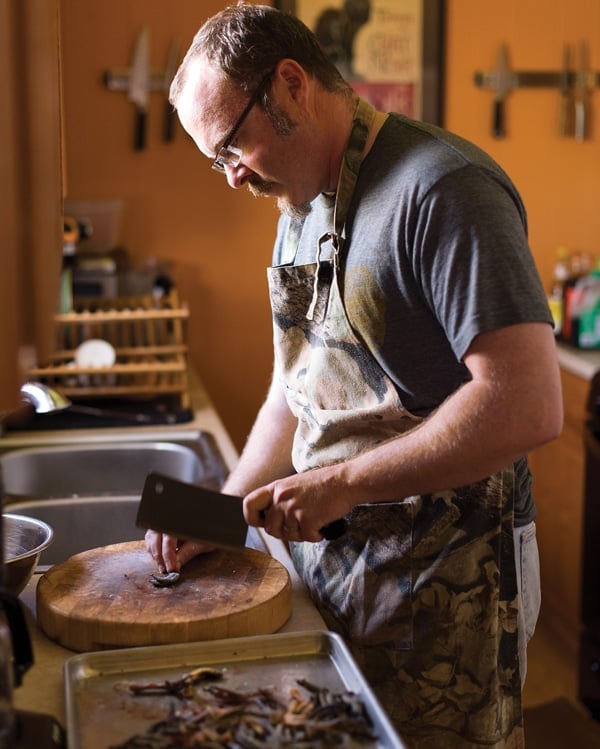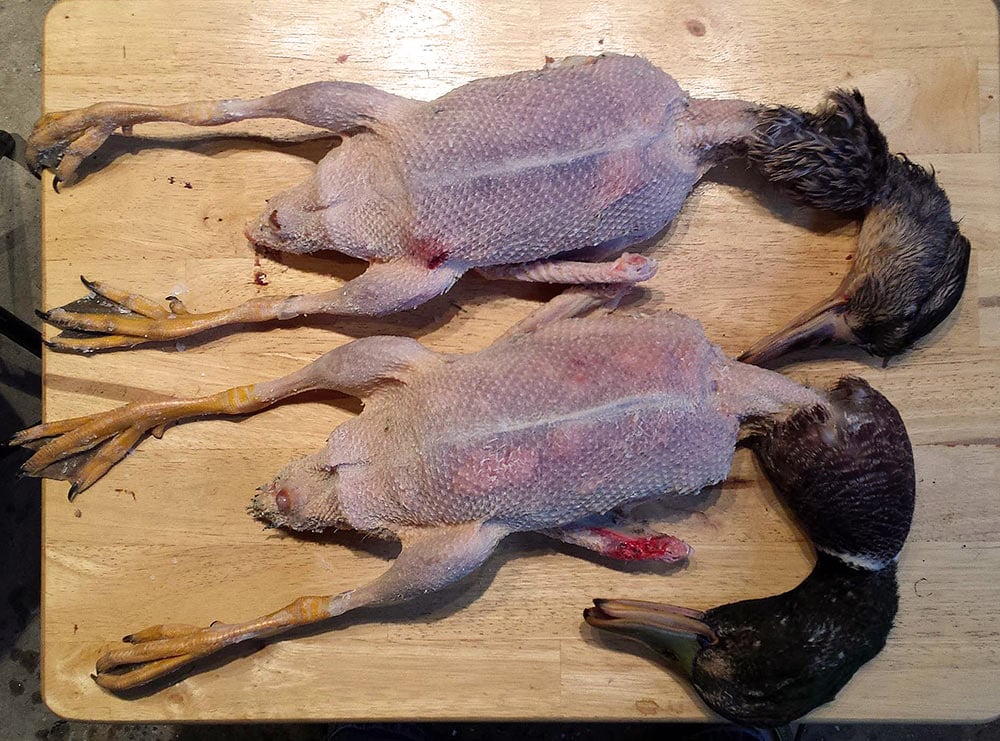As an Amazon Associate I earn from qualifying purchases.

Sometimes life hands you something unexpected. Such was the case last weekend, when Holly and I were hunting ducks in the Grasslands, a vast warren of marsh in California’s San Joaquin Valley south of Sacramento. This is teal country, and mallards are a relative rarity. So when a flock of a dozen or so mallards roared in on us — just as we’d unloaded to leave, incidentally — we considered ourselves lucky to have dropped a pair of them.
But the second I picked up a hen mallard our host Charlie’s dog Bella had found, I felt a tremor of unease. The bird was off somehow. It looked like a hen mallard, but something wasn’t right. Holly’s drake was similar. Certainly a mallard, but off just a bit.
We got them home and noticed the drake’s head hadn’t fully molted, and the legs on both birds were strangely washed out and covered in lumps bird biologists call bumblefoot. And both birds were impossibly lean. Hunger strike skinny, to an extent I’d only seen in crippled birds before. What happened? Were these hybrid mottled ducks, flown up from Mexico? Escaped park ducks? Other than their odd feathers and extreme leanness, they did not look sick.
Maybe they were just very old? When I snipped their tails off to gut them, the bones in their pelvis were unusually thick and hard. And their feet certainly looked heavily walked upon. Clearly these birds had a story, and it was a tough one well before they met the steel of flying shotgun pellets. Regardless, the pair are sitting in my fridge, ready to cook.

But what to do with them? I am so used to well-upholstered ducks and geese here in sunny California that I was at a loss.
I could turn the birds into a broth, shredding the meat and using it that way. Certainly I could braise the legs and wings into submission, and it would be an interesting exercise to see how long that might take. A normal wild duck needs about 2 1/2 hours for the legs to really get tender, wings maybe 30 minutes to an hour longer. But as anyone who has braised lots of wild birds legs or wings will attest, there’s always that ancient one in the mix that’s still rock hard even after 3 hours in simmering sauce. Occupational hazard. I once cooked a batch of French coq au vin with a six-year-old rooster that remains the gnarliest thing I’ve ever cooked — it took a full 7 hours to get tender. If I had to put money on it, I’d bet these mallards might give that old rooster a run for its money.
I mention all this to remind all of you working with wild food that chaos theory rules our kitchens. The variables of what we bring home on a weekly or daily basis boggle comprehension, and would flummox most of the great chefs.
Think about just these mallards for a moment. How old are they? We don’t know, but we can guess old. They’re emaciated, so our usual plans for cooking nice fat birds goes out the window. What were they eating? There was nothing in their crops, so no telling in a proximate way, but longer term, what had these mallards subsisted on? If you know mallards, you know they can literally eat anything, from grain to grass to tadpoles, dead fish and clams. As one British writer noted, mallards can range from dodgy to sublime.
Pigs and bears are the same way. They too are omnivores and will taste strongly of whatever it was they had been living off in the weeks prior to you shooting them. I’ve smelled bear fat that stunk like low tide in August, and have seen wild hogs as skinny as those mallards. I’ve also seen glorious wild pigs that might as well have been a Duroc or Tamworth, and bears so laden with snowy white fat that it yielded a supply of bear lard that lasted a full two years.
Anglers face this problem, too. Bluefish in the Northeast normally eat menhaden, where in North Carolina they will often eat cleaner, less oily fish. Salmon caught in the early season here in NorCal will have eaten krill, while late-season chinook will be eating oilier sardines and anchovies. A krill fish is notably superior to a ‘chovy fish. Crappies caught in warm water will be softer and blander than those caught in cold water, or through the ice. And catfish can be all over the map.
In general, it all boils down to a few major variables.
- Age. I’ve shot mallards that were teenagers and young of the year. A spike elk and a dominant bull can be a decade apart in age. A 40-pound striped bass will be exponentially older than an eight-pounder, as will a 10-pound bass caught in Wisconsin versus a 10-pounder caught in Southern California. In general, the older the animal, the tougher it will be, although there are ways to mitigate this, such as dry aging.
- Condition. Wild animals work for a living. Sometimes you can catch them when they are (or were, considering they’re dead now) fat and happy, and sometimes, like with these mallards, you catch them in times of stress. I’ve shot multiple wigeon on the same day, and some were plump and others rail thin. A fat, alfalfa-eating doe is not the same as a wise old matriarch of a mule deer clan. Nor is the same buck shot before the rut versus after; a pre-rut buck will always be in better condition for the table than one shot right afterwards.
- Species. Think about how many species we come home with, as opposed to what a non-hunter or non-angler might. There are more than two dozen species of duck alone we can hunt in North America, and each has its advantages and disadvantages in the kitchen. No “civilian” can grock this fundamental fact. A sagey mule deer won’t be the same as a cornfield whitetail, and a chinook is most definitely not a chum salmon – er, sorry, “keta,” as the marketers would have you call it now.
- Region. A cottontail from California’s Central Valley may be cute, but it will be tiny and thin. The same species shot in Montana or Minnesota will be a full pound heavier and downright plush. A Coues deer and and a buck from Alberta are both whitetail, but the Canadian deer can outweigh the desert-dwelling Coues by 200 pounds or more.
- Diet. Related to region, I’ve mentioned this one above, but it bears repeating. I would much rather eat wigeon from the NorCal rice fields than from the coast of Oregon, where they are legendarily stinky. Ditto for black brant, which are repulsive on Long Island but ethereal along the Pacific Coast. Snow geese eating peas in Saskatchewan can be morbidly obese, while those here in NorCal are skinny. I’d rather eat a pigeon that had been pillaging grain than one with cigarette butts and Doritos in its crop.
Taken together, it does present a challenge to the cook. But it is not an insurmountable one, and what’s more it is a fascinating problem to have. Each animal you bring home is that figurative special and unique snowflake, a present from nature to be unwrapped and enjoyed on its own terms. Maybe I won’t be able to roast these two Grasslands mallards like I’d wanted to, but their unusual condition has forced me into thinking about these birds differently. Separately, as the individuals they were. And in a way, that is an honor few animals that are eaten by other animals ever get.



